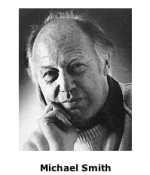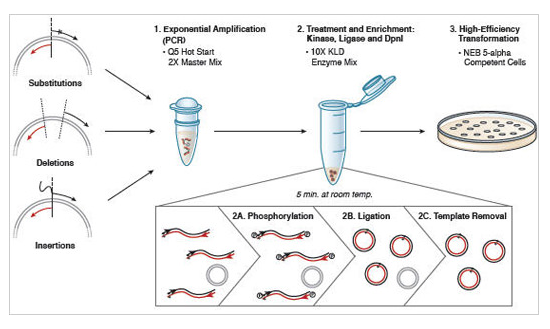Difference between revisions of "20.109(S16):Site-directed mutagenesis (Day3)"
Noreen Lyell (Talk | contribs) (→Part 4: Paper discussion) |
Noreen Lyell (Talk | contribs) (→Introduction) |
||
| Line 4: | Line 4: | ||
==Introduction== | ==Introduction== | ||
| − | |||
| − | |||
| − | |||
| − | |||
| − | |||
| − | |||
| − | |||
| − | |||
| − | |||
| − | |||
[[Image:20.109_SDM-Nobel.png|thumb|right|150px| 1993 Chemistry Nobel Prize co-winner (with Kary Mullis, inventor of PCR) for developing site-directed mutagenesis.]] | [[Image:20.109_SDM-Nobel.png|thumb|right|150px| 1993 Chemistry Nobel Prize co-winner (with Kary Mullis, inventor of PCR) for developing site-directed mutagenesis.]] | ||
Revision as of 20:39, 6 January 2016
Contents
Introduction
After examining both two- and three-dimensional protein information, you will select primers that incorporate a mutation to the wild-type inverse pericam protein and use site-directed mutagenesis to incorporate the corresponding base pair changes. The site-directed mutagenesis (SDM) strategy you will use shares some features with the polymerase chain reaction (PCR) for DNA amplification. Recall from Module 1 that PCR amplification involves multiple cycles of melting, annealing, and extending. To create one or more base-pair mutations in the product DNA, primers that have a slight mismatch to the original template can be used. At a low enough annealing temperature (~25 °C below the primer melting temperature as defined for mutagenesis), these nearly-complementary primers will still anneal to the template DNA, but the copies created during the extension phase will contain the mutation.
You will combine the mutagenic primers of your choice with plasmid DNA encoding wild-type inverse pericam. These will be acted upon by a DNA polymerase to generate a plasmid that carries the inverse pericam gene. Even more copies of the mutant plasmid can be made by introducing it into bacteria in a process called transformation, which you are familiar with from Module 1. Remember that there is still parental -- that is, non-mutant -- DNA present in your SDM reaction mixture. In order to propagate only the mutant plasmid upon introduction into bacteria, the parental DNA is selectively digested using the DpnI enzyme prior to bacterial transformation. The underlying selective property is that DpnI only digests methylated DNA. Therefore, the synthetically made (and thus non-methylated) mutant DNA is not digested, while the parental DNA is digested due to methylation by the host bacterial strain originally used to amplify it. The resulting small linear pieces of parental DNA are simply degraded by the bacteria, whereas the intact (due to a ligation reaction) mutant DNA is amplified by the bacteria.
Now might be a good time to mention why we care about measuring intracellular calcium in the first place. Calcium is involved in many signal transduction cascades, which regulate everything from immune cell activation to muscle contraction, from adhesion to apoptosis - see for example this review by David Clapham in Cell, or this one by Ernesto Carafoli in PNAS. Intracellular calcium (Ca2+) is normally maintained at ~100 nM, orders of magnitude less than the ~mM concentration outside the cell. ATPase pumps act to keep the basal concentration of cytoplasmic calcium low. Often calcium acts as a secondary messenger, i.e., it relays a message from the cell surface to its cytoplasm. For example, a particular ligand may bind a cell surface receptor, causing a flood of calcium ions to be released from the intracellular compartments in which they are usually sequestered. These free ions in turn may promote phosphorylation or other downstream signaling.
The proteins that bind calcium do so with a great variety of affinities, and have roles ranging from sequestration to sensing. Some calcium responses may have long-term effects, particularly in the case of transcription factors that can bind calcium. As discussed in lecture, calmodulin works as a calcium sensor by undergoing a conformational change upon calcium binding. Your goal today is to generate mutant calmodulin (in the context of inverse pericam) DNA, in an attempt to alter the affinity of the resulting protein for calcium.
After today's lab session, the teaching faculty will transform your mutated plasmids into cells that are able to generate multiple copies. When you return you will receive your purified (and hopefully mutated) plasmid. The details will be discussed further during prelab.
Protocols
Part 1: Communications workshop
Part 2: Primer preparation
Part 3: Site-directed mutagenesis
We will be using the Q5 Site Directed Mutagenesis Kit from NEB to perform your site-directed mutagenesis reactions. Each group will set up one reaction, for their chosen X#Z mutation. Meanwhile, the teaching faculty will set up a single positive control reaction, to ensure that all the reagents are working properly. You should work quickly but carefully, and keep your tube in a chilled container at all times. Please return shared reagents to the ice bucket(s) from which you took them as soon as you are done with each one.
- Get a PCR tube and label the top with your mutation and lab section (write small!).
- Add 10.25 μL of nuclease-free water.
- Add 1.25 μL of your mutagenesis primer mix (both primers are at a stock concentration of 10 μM).
- Add 1 μL of IPC template DNA (at a stock concentration of 25 ng/μL).
- Lastly, use a filter tip to add 12.5 μL of Q5 Hot Start High-Fidelity 2X Master Mix - containing buffer, dNTPs, and polymerase - to your tube.
- Once each group is ready, we will begin the thermocycler, under the following conditions:
| Segment | Cycles | Temperature | Time |
|---|---|---|---|
| Initial denaturation | 1 | 98 °C | 30 s |
| Amplification | 25 | 98 °C | 10 s |
| 55 °C | 30 s | ||
| 72 °C | 2 min | ||
| Final extension | 1 | 72 °C | 2 min |
| Hold | 1 | 4 °C | indefinite |
- After the cycling is completed, the teaching faculty will complete the KLD reaction (which stands for "kinase, ligase, DnpI") using 1 μL of your amplification product, 5 μL 2X KLD Reaction Buffer, 1 μL KLD Enzyme Mix, and 3 μL nuclease-free water. The reactions will be incubated for 5 min at room temperature.
- The teaching faculty will then use 5 μL of the KLD reaction product to complete a transformation into an E. coli strain (NEB 5α cells of genotype fhuA2 Δ(argF-lacZ)U169 phoA glnV44 Φ80 Δ(lacZ)M15 gyrA96 recA1 relA1 endA1 thi-1 hsdR17) that will amplify the plasmid such that you are able to confirm the appropriate mutation was incorporated. The transformation procedure will be as follows:
- Add 5 μL of KLD mix to 50 μL of chemically-competent NEB 5α.
- Incubate on ice for 30 min.
- Heat shock at 42 °C for 30 sec.
- Incubate on ice for 5 min.
- Add 950 μL SOC and gently shake at 37 °C for 1 hour.
- Spread 50 μL onto LB amp plate and incubate overnight at 37 °C.
Part 4: Journal article discussion
The purpose of this discussion will be two-fold: 1) to familiarize ourselves with the history of protein design, and 2) to continue to explore ways of talking about the scientific literature.
If you chose to read the paper by Heim, Prasher, and Tsien, consider the following questions.
- What are the advantages of GFP compared to synthetic fluorescent dyes, and what are its limitations? Which of these limitations are Heim et al. trying to address?
- What methods did the authors use for mutagenesis, and how do they compare to the method we are using?
- How were mutagenic proteins initially selected, and how were the chosen ones further analyzed?
- What is the significance of the different wild-type protein fractions shown in Figure 1?
- If GFP maturation does not require any cofactors for a chemical reaction, why does it take four hours? What lines of evidence suggest the absence of cofactors?
- In what part(s) of the protein were useful amino acid substitutions found?
We will not have the opportunity to discuss these questions as a class, but feel free to ask the teaching faculty any questions you may have concerning the journal article.
You should be familiar with the whole Nagai et al paper, but your team will only be asked to explain/describe the portion assigned below. Use the questions associated with your section to guide you as you prepare for the group discussion.
- GROUP DISCUSSION Introduction, Methods (gene construction) and Figure 1
- Consider: What is a chimeric protein? A circularly permuted one?
- How does the chimeric protein pericam work as a sensor? (No need for details about different types of pericams yet.)
- Briefly summarize how pericam was constructed at the gene level. What changes had to be made to express pericam in mammalian rather than bacterial cells?
- T/R RED TEAM and W/F BLUE TEAM Figure 2
- What do the authors learn about cpEYFP structure from the absorbance spectra?
- Compare the wavelength used for testing pericam with the excitation maximum of cpEYFP. Why might they be slightly different?
- Besides making the critical mutations shown in Table 1, what did the authors have to do to make a working (fluorescent, calcium-sensitive) pericam?
- What was the dynamic range (intensity change with calcium addition) of the first working cpEYFP?
- T/R ORANGE TEAM and W/F YELLOW TEAM Table 1 (mutations) and Figure 3, A-I (focus on D-F)
- Describe the three types of pericam initially constructed and tested and how they respond to calcium.
- What kinds of amino acid substitutions were made, and why might they cause the noted effects?
- T/R BLUE TEAM and W/F GREEN TEAM Table 1 (Kd) and Figure 3, J-L
- This set of figures is very similar to the one you will eventually create for your lab reports. It is not described at length in the text, so take a moment to decipher the axes and results as best you can, using outside resources if necessary.
- T/R GREEN TEAM and W/F RED TEAM Figure 4 and Figure 5
- How does flash-pericam improve upon previous limitations to imaging calcium in the nucleus and cytosol?
- What chemicals can be used to create step-changes in intracellular calcium, and how might they work?
- How did the authors calibrate calcium levels?
- Compared to the other pericams, what's special about the way split-pericam functions?
- What are the limitations of using split-pericam as a calcium sensor?
- PINK TEAM Figure 6
- What modifications were made to pericam for organelle-level study, and how does the use of pericams improve upon previous procedures?
- What were the authors able to learn about calcium transients in different organelles?
- GROUP DISCUSSION Wrap-up
- Describe some other (not pericam-based) calcium indicators.
- How does FRET work, and what are the pros/cons of using FRET-based sensors?
Finally, you should all consider the similarities and differences between the research described in the paper above and the research that you are undertaking in this module.
Reagent list
- Q5 Site Directed Mutagenesis Kit from NEB
- Q5 Hot Start High-Fidelity 2X Master Mix
- Propriety mix of Q5 Hot Start High-Fidelity DNA Polymerase, buffer, dNTPs, and Mg2+.
- 2X KLD Reaction Buffer
- 10X KLD Enzyme Mix
- Proprietary mix of kinase, ligase, and DpnI enzymes.
- Q5 Hot Start High-Fidelity 2X Master Mix
- The SOC medium contains 2% tryptone, 0.5% yeast extract, 10 mM NaCl, 2.5 mM KCl, 10 mM MgCl2, 10 mM MgSO4, and 20 mM glucose.
- Ampicillin: 100 mg/mL, aqueous, sterile-filtered
Next day: Prepare expression system


